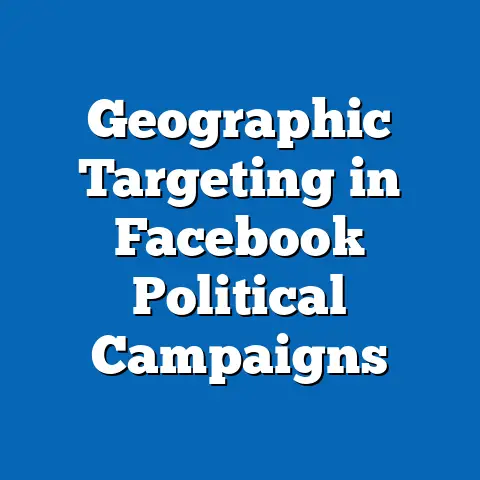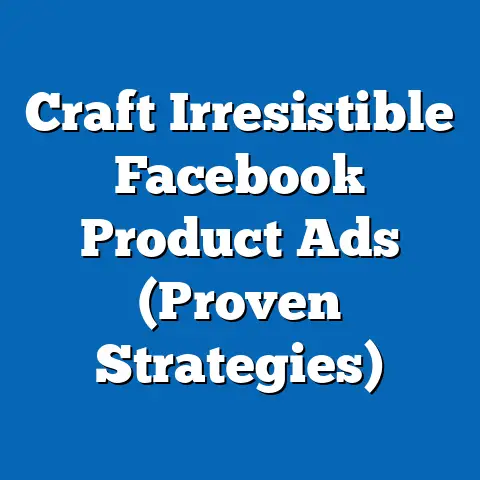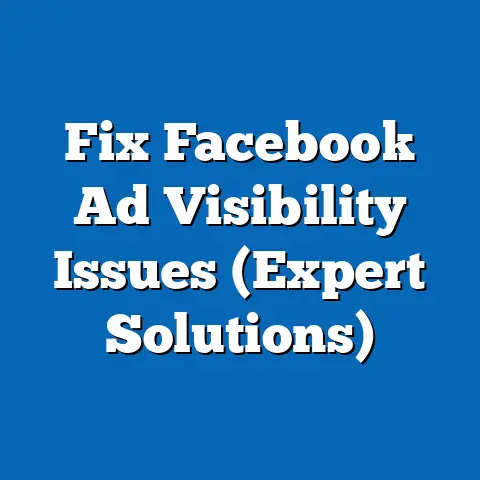Overcoming Facebook Ad Account Limits (Expert Solutions Revealed)
A single oversight can derail even the most meticulously planned advertising campaign. One of the most common yet devastating mistakes businesses make is failing to understand and address Facebook ad account limits, resulting in restricted accounts, halted campaigns, and significant financial losses. This misstep often stems from a lack of awareness about platform policies, improper scaling strategies, or inadequate account management practices.
Facebook, now under the umbrella of Meta, has become a cornerstone of digital advertising, with over 10 million active advertisers and a global reach of 2.9 billion monthly active users as of 2023 (Meta, 2023). For businesses of all sizes, the platform offers unparalleled opportunities to target specific demographics with precision. However, its stringent policies and complex algorithms also pose challenges, particularly when it comes to ad account limits—restrictions placed on spending, ad creation, or account access due to policy violations, payment issues, or suspicious activity.
Defining Facebook Ad Account Limits: Characteristics and Scope
Facebook ad account limits refer to restrictions imposed by the platform on an advertiser’s ability to create, manage, or fund advertising campaigns. These limits can manifest in several forms, including daily or lifetime spending caps, restrictions on the number of ads or ad sets, or complete account suspensions. They are typically triggered by factors such as policy violations (e.g., prohibited content or misleading claims), payment failures, rapid account scaling without proper warm-up, or suspicious activity flagged by Meta’s automated systems.
Unlike temporary holds or minor warnings, ad account limits can have a cascading effect, disrupting not only current campaigns but also long-term marketing strategies. For instance, a sudden spending cap can prevent a business from capitalizing on peak seasonal demand, while a full suspension can sever access to critical audience data. According to a 2022 survey by Social Media Examiner, nearly 40% of digital marketers reported experiencing ad account restrictions at least once, with small businesses and new advertisers being particularly vulnerable due to limited resources and expertise.
It’s important to note that limits are not applied uniformly across all accounts. Factors such as account age, historical compliance, and advertising spend influence how Meta evaluates and restricts accounts. A nuanced understanding of these variables is essential for advertisers seeking to mitigate risks and maintain campaign momentum.
Historical Context: The Evolution of Meta’s Advertising Policies
To fully grasp the significance of ad account limits, it’s crucial to examine the historical context of Meta’s advertising ecosystem. When Facebook first introduced its advertising platform in 2007, it was a relatively open space with minimal oversight, allowing businesses to experiment with creative formats and targeting options. However, as the platform grew, so did concerns over user privacy, misinformation, and unethical advertising practices.
The 2016 U.S. presidential election marked a turning point, with revelations about Cambridge Analytica’s misuse of user data exposing significant vulnerabilities in Meta’s advertising system. This scandal prompted a wave of regulatory scrutiny and public backlash, leading Meta to implement stricter policies on ad content, transparency, and account management. By 2018, the platform introduced mandatory identity verification for political advertisers and began using AI-driven tools to detect policy violations more proactively.
Over the next few years, Meta continued to refine its policies, introducing spending limits and account warm-up periods to prevent fraud and ensure compliance. The 2020 global pandemic further accelerated these changes, as a surge in online advertising led to increased instances of scams and low-quality ads. Meta’s response was to tighten restrictions, often catching legitimate advertisers in the crossfire. Today, ad account limits are a byproduct of this heightened vigilance—a mechanism designed to protect the platform’s integrity but one that can inadvertently penalize compliant businesses.
This historical trajectory underscores a broader societal shift toward accountability in digital spaces. While Meta’s policies aim to safeguard users, they also reflect the growing tension between platform control and advertiser autonomy, raising questions about fairness and accessibility in the digital economy.
Societal and Economic Implications of Ad Account Limits
The impact of Facebook ad account limits extends far beyond individual businesses, influencing broader societal and economic dynamics. For small and medium-sized enterprises (SMEs), which account for over 90% of Meta’s advertisers, these restrictions can be particularly crippling. A 2021 report by the U.S. Small Business Administration noted that digital advertising is a primary growth driver for SMEs, with many relying on platforms like Facebook to reach niche markets cost-effectively. When limits disrupt campaigns, these businesses often lose critical revenue streams, stunting growth and innovation.
On a societal level, ad account limits contribute to a growing digital divide. Larger corporations with dedicated compliance teams and substantial budgets can navigate Meta’s policies more effectively, while smaller players struggle to keep up. This disparity risks entrenching economic inequality, as access to digital advertising—a key tool for market entry—becomes increasingly stratified.
Moreover, the opaque nature of Meta’s limit enforcement raises concerns about transparency and accountability. Advertisers often report receiving vague notifications about violations, with limited avenues for appeal. This lack of clarity can erode trust in the platform, prompting some businesses to seek alternatives like Google Ads or TikTok, which may have their own set of challenges. As digital advertising shapes consumer behavior and cultural trends, the ripple effects of these limits influence everything from product visibility to public discourse.
Root Causes of Ad Account Limits: A Multifaceted Challenge
Understanding why ad account limits occur is the first step toward overcoming them. One primary cause is policy non-compliance, which can range from using prohibited content (e.g., explicit imagery or false claims) to violating community standards. Meta’s 2023 Transparency Report revealed that over 1.5 billion pieces of content were removed for policy violations, with a significant portion tied to advertising accounts.
Another common trigger is payment issues, such as declined transactions or discrepancies in billing information. These problems often arise when advertisers scale campaigns rapidly without updating payment methods or securing sufficient funds. Similarly, new accounts or those with low spending history are subject to stricter scrutiny, as Meta’s algorithms flag them for potential fraud during the “warm-up” phase.
Behavioral factors also play a role. For example, creating multiple ad accounts under a single business manager, excessive ad edits, or targeting overly sensitive demographics can raise red flags. A 2022 study by Digital Marketing Institute found that 65% of account limits were linked to user error rather than malicious intent, highlighting the need for education and proactive account management.
Expert Solutions: Strategies to Overcome and Prevent Limits
Navigating Facebook ad account limits requires a combination of strategic foresight and tactical expertise. Below are proven solutions from industry leaders and data-driven insights to help advertisers maintain compliance and optimize performance.
1. Build a Strong Account Foundation
Before launching campaigns, ensure your ad account is set up for success. Verify your business identity through Meta’s Business Manager, link a reliable payment method, and start with small, consistent ad spends to establish trust. Experts like Jon Loomer, a renowned digital marketing consultant, emphasize the importance of a gradual “warm-up” period, recommending that new accounts spend no more than $50-$100 per day initially to avoid triggering limits.
Additionally, maintain a single, well-documented ad account rather than creating multiple accounts, which can be perceived as an attempt to bypass restrictions. Transparency in account setup is key to building credibility with Meta’s systems.
2. Prioritize Policy Compliance
Familiarize yourself with Meta’s Advertising Policies and Community Standards, which are regularly updated to reflect new regulations and user expectations. Use tools like the Ad Library to benchmark compliant campaigns and avoid common pitfalls such as exaggerated claims or restricted content categories (e.g., alcohol or financial products).
If a violation occurs, address it promptly by revising content and submitting an appeal through Meta’s support channels. A 2023 survey by Hootsuite found that 70% of advertisers who proactively corrected violations regained full account access within two weeks, underscoring the value of responsiveness.
3. Optimize Payment and Scaling Practices
To prevent payment-related limits, ensure your billing information is accurate and your funding source has sufficient balance before scaling campaigns. When increasing ad spend, do so incrementally—experts suggest a 20-30% daily increase to avoid triggering algorithmic flags. Tools like automated rules can help monitor spend thresholds and pause campaigns if anomalies are detected.
For businesses with high-volume campaigns, consider requesting a dedicated account manager through Meta’s support team. While not available to all advertisers, this service can provide personalized guidance on scaling without risking restrictions.
4. Leverage Data and Analytics for Risk Mitigation
Data-driven decision-making is critical for avoiding limits. Use Meta’s Ads Manager to track performance metrics and identify patterns that could lead to restrictions, such as high negative feedback scores or low relevance scores. Third-party tools like AdEspresso or Sprout Social can also provide deeper insights into compliance risks.
Regularly audit your campaigns for potential issues, such as outdated targeting parameters or broken landing pages. By staying ahead of problems, you reduce the likelihood of automated flags and maintain campaign continuity.
5. Build Resilience Through Diversification
While Facebook remains a dominant advertising platform, relying solely on it can be risky given the potential for limits and suspensions. Diversify your marketing strategy by exploring other channels like Google Ads, LinkedIn, or emerging platforms like TikTok. This approach not only mitigates risk but also broadens your audience reach.
Industry expert Mari Smith advises creating a “multi-platform safety net,” where no single channel accounts for more than 50% of ad spend. This strategy ensures business continuity even if a Facebook account faces restrictions.
Case Studies: Real-World Applications of Expert Solutions
To illustrate the effectiveness of these strategies, let’s examine two real-world examples of businesses overcoming ad account limits.
Case Study 1: E-Commerce Startup Recovery A small e-commerce startup faced a spending cap after scaling its holiday campaign too quickly, jumping from $100 to $1,000 daily spend within a week. By following expert advice, the company reduced its spend to $200 per day, updated its payment method, and submitted a detailed appeal to Meta. Within 10 days, the cap was lifted, and the startup adopted a 25% daily scaling rule to prevent future issues. This case highlights the importance of gradual scaling and proactive communication with Meta.
Case Study 2: Agency Account Suspension Turnaround A digital marketing agency managing multiple client accounts encountered a full suspension due to a policy violation in one campaign. The agency conducted a thorough audit, identified the offending ad (which contained misleading health claims), and worked with Meta’s support team to rectify the issue. By implementing stricter internal compliance checks and diversifying ad spend across platforms, the agency regained access and avoided similar disruptions. This example underscores the value of internal processes and platform diversification.
Nuances and Challenges in Addressing Ad Account Limits
While the solutions outlined above are effective, it’s important to acknowledge the nuances and challenges inherent in dealing with ad account limits. Meta’s automated systems, while sophisticated, are not infallible and can flag legitimate accounts due to false positives. A 2022 report by TechCrunch noted that over 30% of appealed suspensions were overturned, indicating a significant margin of error in initial decisions.
Additionally, the diversity of advertiser needs means that a one-size-fits-all approach is impractical. For instance, a local business with a modest budget may prioritize compliance over scaling, while a global brand may need advanced tools to manage high-volume campaigns. Tailoring strategies to specific contexts is essential for long-term success.
Cultural and regional differences also play a role. Advertisers in heavily regulated markets like the European Union, where GDPR imposes strict data usage rules, face unique compliance challenges compared to those in less regulated regions. Understanding these variations ensures that solutions are both relevant and effective.
Implications for the Future: Society, Business, and Technology
Looking ahead, the issue of Facebook ad account limits will continue to shape the digital advertising landscape. For businesses, the need for agility and compliance will only grow as Meta refines its algorithms and responds to regulatory pressures. The rise of AI-driven moderation tools promises more precise enforcement but also raises concerns about transparency and bias in decision-making.
From a societal perspective, ad account limits highlight the broader tension between innovation and regulation in the digital economy. As platforms like Meta wield increasing influence over market access, policymakers may push for clearer guidelines and stronger advertiser protections. The European Union’s Digital Services Act (DSA), implemented in 2023, is a step in this direction, mandating greater transparency in platform policies.
Technologically, advancements in machine learning and blockchain could offer new solutions for advertisers. For instance, decentralized advertising platforms may emerge as alternatives to centralized systems like Meta, reducing the risk of arbitrary limits. However, such innovations are still in their infancy, and their scalability remains uncertain.
Workplace and Cultural Impacts of Ad Account Restrictions
In the workplace, ad account limits have prompted a shift in how marketing teams operate. Many organizations now prioritize hiring compliance specialists or investing in training to navigate Meta’s policies. This trend reflects a broader cultural shift toward digital literacy as a core competency in business.
Culturally, the frustration surrounding limits has sparked discussions about the power dynamics between platforms and users. Online communities of marketers, such as those on Reddit and LinkedIn, frequently share tips and grievances about Meta’s policies, fostering a collective push for greater accountability. This grassroots movement may influence how platforms engage with advertisers in the future.
Quantitative Insights: The Scale of the Challenge
Statistics paint a stark picture of the ad account limit challenge. According to a 2023 report by Statista, over 50% of small business advertisers on Meta experienced some form of account restriction in the past year, with 20% facing full suspensions. The financial impact is significant, with affected businesses reporting average losses of $5,000-$10,000 per incident due to halted campaigns and lost opportunities.
On the flip side, Meta’s efforts to curb fraud have yielded results. The platform reported blocking over 7 million fake accounts tied to advertising fraud in 2022, suggesting that limits, while disruptive, play a role in maintaining ecosystem integrity. Balancing these competing priorities remains a central challenge for both Meta and its users.
Conclusion: Navigating Uncertainty with Strategic Insight
Facebook ad account limits represent a complex and multifaceted challenge for digital marketers, rooted in the platform’s evolving policies and the broader push for accountability in online spaces. While these restrictions can disrupt campaigns and exacerbate economic disparities, they also reflect Meta’s commitment to user safety and platform integrity. By understanding the causes of limits and adopting expert-driven solutions—such as building strong account foundations, prioritizing compliance, and diversifying ad strategies—businesses can mitigate risks and sustain growth.
Looking forward, the landscape of digital advertising will continue to shift, shaped by technological innovation, regulatory developments, and cultural attitudes toward platform power. While uncertainties remain, particularly around the scalability of alternative platforms and the precision of automated moderation, advertisers who invest in education and adaptability will be best positioned to thrive. As the digital economy evolves, overcoming ad account limits is not just a tactical necessity but a strategic imperative for businesses seeking to navigate the complexities of the modern marketplace.






